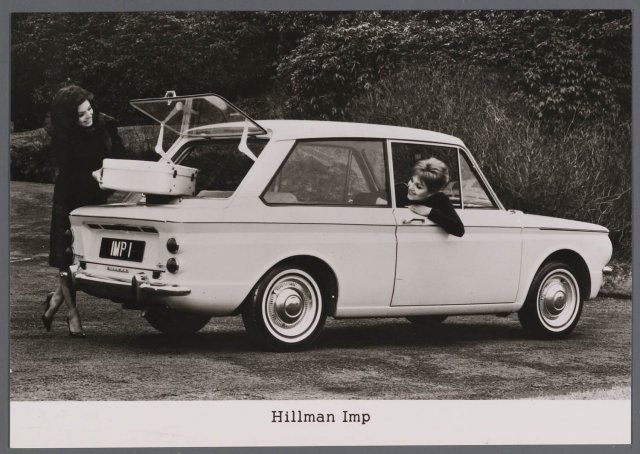In 1963, the Rootes Group launched the Hillman Imp, as an antidote to Earth-rival British Motor Corporation's successful Mini. The Imp was a lot more conventional than its stubborn counterpart. It was just a small car with the rear engine and rear wheel drive. Characteristic is that the motor was made of aluminum. The cylinder capacity was 875 cc, the power output was just 40 hp. A 998 cc power source for the Hillman Imp would later become available for rallying purposes. And in that rally world, the Imp has resisted strongly.
All subsidy and good intentions
With a lot of government support, a new factory is being built in Linwood, Scotland. In that region there was enormous unemployment as a result of the mine closings. There was another thing: great social dissatisfaction. Riot threatened. The new factory would create work for 6000+ people. It was not really thought whether the hulls would work in factories.
An Imp for the whole family
The Hillman Imp is presented as a family car. In the front was a small trunk, behind the back seat is extra space for luggage. It was very convenient to reach via a folding rear window. The start of the new car was unfortunate. The concept of "teething" seems to have been invented for the Hillman Imp. The engine, clutch and gearbox were not very reliable during the first production time. The Imp did not seem to be fully developed when production started. That was a case of 'hasty urgency'…
Messy logistics
In addition, the production process was poorly structured, complicated and expensive. Parts of the Hillman Imp came to Scotland from the Ryton plant near Coventry, nearly 500 kilometers from Linwood. This meant that things did not run more smoothly.
Heibel in the tent
The Linwood plant was then quickly faced with the labor unrest that in those days kept the United Kingdom in a kind of stranglehold. The unions determined. However senseless the demands were. And in a cabinet company like the British, that was not fought in good conversations. The case was closed. And people who wanted to work were made work impossible. Point.
Three weeks after the opening, the unions stopped production in Linwood. In the first 'production year', from this perspective, there were more than thirty production stops that, according to the unions, had everything to do with labor problems among the employees.
Staking sometimes destroys more than you like
Staking sometimes destroys more than you would like. But in Linwood, things eventually got started. The Hillman Imp series ended up in production for 14 years. At that time, some 400.000 left the factory. The original forecasts were also based on 150.000 per year. So whether those 400.000 were many? Whether the Hillman Imp was a success?
In 1967 Chrysler took over the ramshackle Rootes group. That was after Simca had already come under the Chrysler Europe umbrella in France. With the British purchase, the Americans wanted to get a grip on the car market on the European mainland and that of the then still fairly large Britain. The European adventure did not produce the expected success. After twelve years, Chrysler transferred its European branch to Peugeot. That was also the end of the once illustrious brand names Hillman, Singer and Sunbeam. These could be added to the history books.
And the red Hillman Imp in the pictures below? It ended badly with that.
Also interesting to read:
- Hillman Imp Estate
- Chrysler Sunbeam, the last new car from Linwood
- FIAT, Simca, Chrysler and Talbot
- The Talbot Sunbeam Lotus: A wolf in sheepskin
- Chrysler Simca 2 liters. What was the intention again?







in 1973 I bought a Sunbeam Imp during my service because a roommate had the same one but from Hillman, I thought it was a nice car. a few months later, a roommate came in who owned the same car but in a coupe version. this was not an Imp but a Chamois. he worked as a mechanic at a Rootes garage and bought it as a trade-in. I have never seen a Chamois since. is this version known to the editors?
Harika Bilgi. Blogunuzun geri kalanını kontrol edeceğim.
A thousand kilometers south-east of Linwood was Bochum, where ex-miners put an equally new car into production in an equally new factory: the Opel Kadett. Factory and Kadett ran smoothly from day one and were an unparalleled success. The same happened in Genk, where Ford started production of the P4 / Taunus 12m with ex-miners who were happy to finally experience clean air and daylight.
The Rootes Group had two more brands that should be mentioned: Commer produced trucks and is sometimes worth an article because of the Commer TS3 engine, a three-cylinder double-piston two-stroke = turbo diesel diesel, also called “Knocker”, an absolutely unique engine block.
And Humber. Humber was Rootes' luxury brand. Humber designed a beautiful luxury, sleek car with lots of leather and wood and built a new production line for it, but the Americans thought it better to produce this typical British car in France where the design of a large Simca in front disappeared into the paper shredder. It became the Chrysler 160/180 / Deux Liters series. The French were angry that they had to make a conventional British car instead of their state-of-the-art fifth-door front-wheel drive. The British were angry that a bunch of Frenchmen put in skai and plastic fake wood instead of British leather and wood veneer. The French dealers were given a British car that did not match Simca customers and the British dealers had to sell a French car they did not trust. Eventually production moved to Franco's Spain where the car continued unchanged for fourteen years, an undeserved fate for such a beautiful and good design.